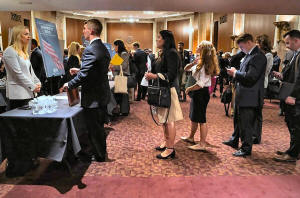|
Strong U.S. job growth expected in
September; wages seen rising
 Send a link to a friend
Send a link to a friend
 [October 05, 2018]
By Lucia Mutikani [October 05, 2018]
By Lucia Mutikani
WASHINGTON (Reuters) - The U.S. economy
likely created jobs at a brisk clip in September, with the unemployment
rate probably falling to an 18-year low of 3.8 percent, signaling a
further tightening in labor market conditions.
The Labor Department's closely watched monthly employment report on
Friday is also expected to show a steady rise in wages, suggesting
moderate inflation pressures, which could ease concerns about the
economy overheating and keep the Federal Reserve on a path of gradual
interest rates increases.
Nonfarm payrolls likely increased by 185,000 jobs last month after
surging 201,000 in August, according to a Reuters survey of economists.
September's anticipated job gains would match the monthly average for
the past three months. The economy needs to create roughly 120,000 jobs
per month to keep up with growth in the working-age population.
"The labor market remains healthy, and we think the Goldilocks scenario
of decent economic growth with tame inflation is poised to continue,"
said Aaron Anderson, head of research at Fisher Investments in San
Francisco.

Fed Chairman Jerome Powell said on Tuesday that the economy's outlook
was "remarkably positive" and he believed it was on the cusp of a
"historically rare" era of ultra-low unemployment and tame inflation.
The U.S. central bank raised interest rates last week for the third time
this year and removed the reference in its post-meeting statement to
monetary policy remaining "accommodative."
A robust labor market is underpinning the economy and together with high
savings could support consumer spending as the stimulus from the Trump
administration's $1.5 trillion tax cut package fades.
Economists expected only a marginal impact on payrolls from Hurricane
Florence, which lashed South and North Carolina in mid-September. The
storm, which caused massive flooding, made landfall at the tail end of
the survey week for payrolls.
"Despite billions of dollars in damages caused by Hurricane Florence,
the storm should have minimal effect on payrolls, as most workers were
paid during at least part of the survey period," said Sal Guatieri,
senior economist at BMO Capital Markets in Toronto.
The government counts a person as employed if they are paid for any part
of the pay period that includes the 12th of the month. But the hurricane
could have cut the workweek and lifted wages as it probably kept workers
in the low-paying restaurant and retail industries temporarily at home.
DIMINISHING SLACK
Average hourly earnings are forecast to have increased 0.3 percent in
September after leaping 0.4 percent in the prior month.
[to top of second column]
|

People wait in line at a stand during the Executive Branch Job Fair
hosted by the Conservative Partnership Institute at the Dirksen
Senate Office Building in Washington, U.S., June 15, 2018. REUTERS/Toya
Sarno Jordan

"Even though storm effects will be limited by the fact that the
hurricane hit relatively late in the survey period, we think they
will be enough to bias the workweek down and increase hourly
earnings," said Lou Crandall, chief economist at Wrightson ICAP in
Jersey City, New Jersey.
With September's increase below the 0.5 percent gain notched during
the same period last year, that would lower the annual increase in
wages to 2.8 percent from 2.9 percent in August, which was the
biggest rise in more than nine years.
Wage growth remains sufficient to keep inflation around the Fed's 2
percent target. As more slack is squeezed out of the labor market,
economists expect annual wage growth to hit 3 percent. The
anticipated 1/10th of a percentage point drop in the unemployment
rate from 3.9 percent in August would push it near the Fed's
forecast of 3.7 percent by the end of this year.
While surveys have shown manufacturers growing more concerned about
an escalating trade war between the United States and China, that
does not appear to have affected hiring. In fact, the Fed's latest
survey of national business conditions reflected concerns about
labor shortages that are extending into non-skilled occupations as
much as about tariffs.
"Many big corporate chiefs are kind of thinking that this is going
to get resolved in some way and they are reluctant to make
significant changes based on what they see as posturing and more of
a negotiating strategy," said Jason Thomas, chief economist at
AssetMark in Los Angeles.
Washington last month slapped tariffs on $200 billion worth of
Chinese goods, with Beijing retaliating with duties on $60 billion
worth of U.S. products. The United States and China had already
imposed tariffs on $50 billion worth of each other's goods.
The trilateral trade agreement between the United States Canada and
Mexico was salvaged in an 11th-hour deal on Sunday.

Manufacturing payrolls likely rebounded in September after declining
in August for the first time in 13 months amid a drop in employment
at motor vehicle assembly plants. Construction companies are
expected to have hired more workers last month after increasing
payrolls by 23,000 jobs in August.
(Reporting by Lucia Mutikani; Editing by Leslie Adler)
[© 2018 Thomson Reuters. All rights
reserved.]
Copyright 2018 Reuters. All rights reserved. This material may not be published,
broadcast, rewritten or redistributed.
Thompson Reuters is solely responsible for this content. |